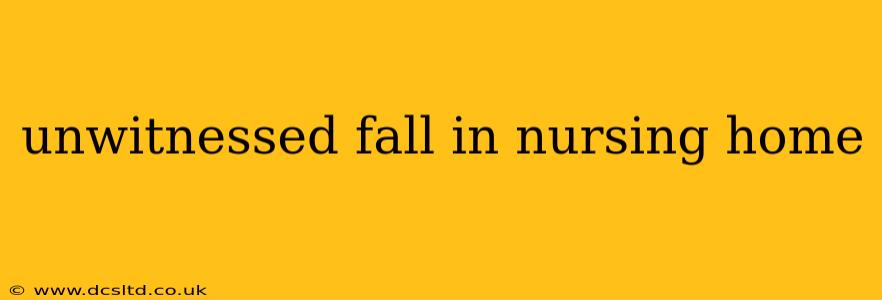Unwitnessed falls in nursing homes are a serious concern, posing significant risks to residents' health and well-being. These incidents often go undetected until their consequences become apparent, leading to delayed treatment and potentially severe complications. This comprehensive guide explores the multifaceted issue of unwitnessed falls, addressing prevention strategies, detection methods, and appropriate responses.
What are the risks associated with unwitnessed falls in nursing homes?
Unwitnessed falls carry a higher risk of severe injury compared to witnessed falls. This is because help isn't immediately available, leading to prolonged periods on the floor, potentially resulting in:
- Head injuries: Falls can cause concussions, skull fractures, and subdural hematomas, particularly in older adults with fragile bones and increased risk of bleeding.
- Hip fractures: These are common and debilitating injuries requiring extensive rehabilitation.
- Other fractures: Falls can lead to fractures in other bones, such as wrists, vertebrae, and ankles.
- Soft tissue injuries: Bruises, sprains, and strains are frequent, potentially leading to chronic pain and reduced mobility.
- Increased risk of mortality: Studies show a correlation between unwitnessed falls and increased mortality rates among nursing home residents.
- Pressure sores (pressure ulcers): Prolonged periods lying on the floor can cause pressure sores, especially in individuals with impaired circulation or limited mobility.
- Dehydration and Hypothermia: Depending on the environment and the resident's health, they may be at risk for dehydration and hypothermia while lying on the floor.
How can nursing homes prevent unwitnessed falls?
Preventing falls is paramount. A multi-pronged approach is crucial, focusing on:
- Regular risk assessments: Thorough assessments of each resident's fall risk factors, including medication side effects, mobility issues, and cognitive impairment, are essential.
- Environmental modifications: Removing hazards, improving lighting, providing assistive devices (walkers, canes), and ensuring a clutter-free environment are key. Non-slip flooring and grab bars in bathrooms are also vital.
- Medication reviews: Regular reviews of medications by a physician or pharmacist can identify drugs that increase fall risk.
- Exercise and physical therapy: Programs tailored to individual needs can improve strength, balance, and coordination, reducing fall risk.
- Staff training: Equipping staff with fall prevention techniques and the ability to identify residents at high risk is essential.
- Regular monitoring: Frequent checks on residents, particularly those identified as high-risk, can help detect impending falls or immediate consequences. This might involve hourly checks for some, while others may need less frequent but still regular observation.
- Use of technology: Sensors and monitoring systems can alert staff to falls or unusual movements.
What are the signs and symptoms of a fall, even if it was unwitnessed?
Detecting unwitnessed falls can be challenging, but there are several potential clues:
- Unexplained bruises or injuries: New bruises or injuries without a clear explanation can suggest a fall.
- Changes in behavior or mood: Confusion, agitation, or unusual lethargy can indicate a fall's impact.
- Pain complaints: Residents may report pain in specific areas of their bodies.
- Difficulty with mobility: Suddenly decreased mobility or a change in gait might indicate a fall.
- Soiled clothing or bedding: This might suggest the resident has been lying on the floor for a period of time.
- Displaced furniture: Knocked-over furniture or objects can sometimes indicate a fall.
How are unwitnessed falls investigated and documented in nursing homes?
Nursing homes should have clear protocols for investigating unwitnessed falls:
- Immediate assessment: Upon discovery of a possible fall, immediate assessment of the resident's condition is necessary.
- Thorough documentation: Detailed records of the incident, including the time of discovery, the resident's condition, any injuries, and actions taken, are essential.
- Incident reports: Formal incident reports should be completed accurately and promptly.
- Review of care plan: The resident's care plan should be reviewed to identify potential contributing factors and implement necessary adjustments.
- Notification of family: Family members should be promptly notified about the incident and the resident's condition.
What technology is available to help detect unwitnessed falls?
Several technological advancements aid in fall detection:
- Pressure sensors: Placed on the floor or in beds, these can detect weight shifts and falls.
- Motion sensors: These detect movement and can alert staff to unusual activity.
- Smartwatches and fitness trackers: Some devices can detect falls and automatically alert emergency contacts.
- Camera systems: While raising privacy concerns, strategically placed cameras can provide visual monitoring.
How common are unwitnessed falls in nursing homes?
The exact prevalence of unwitnessed falls is difficult to determine due to underreporting. However, studies suggest that a significant proportion of falls go unnoticed, highlighting the need for robust prevention and detection strategies.
Conclusion
Unwitnessed falls in nursing homes pose a significant risk to residents' safety and well-being. Proactive fall prevention strategies, coupled with vigilant monitoring and appropriate response protocols, are crucial to minimizing the incidence and severity of these events. Continuous improvement in technology and staff training will play a vital role in enhancing resident safety and reducing the impact of unwitnessed falls.
